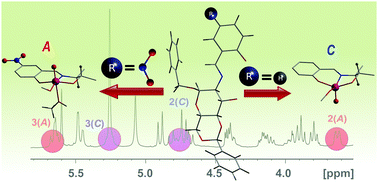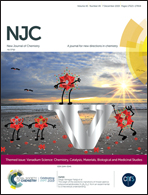Probing the chirality of oxidovanadium(v) centers in complexes with tridentate sugar Schiff-base ligands: solid-state and solution behavior†
Abstract
Four sugar-based chiral oxidovanadium(V) complexes [VO(L)(OMe)] (1), [VO(L5-NO2)(OMe)(MeOH)] (2), [VO(L5-OMe)(OMe)] (3), and [VO(L3-tBu)(OMe)(MeOH)] (4) have been synthesized. The crystal structures of complexes 1 and 2 could be determined by single crystal X-ray diffraction. Complexes 1 and 2 crystallize in the non-enantiogenic orthorhombic P212121 and monoclinic P21 space group, respectively. The structures reveal a difference in the coordination environment at the oxidovanadium(V) centers, where complex 1 is five-coordinate, while 2 is a six-coordinate complex with an additional coordinated methanol ligand. A comparison of the crystal structures of 1 and 2 shows that the vanadium(V) centers are present in different absolute configurations, despite crystallization from the same solvent. In fact, for complex 1, a C configuration at the chiral vanadium(V) center is found, which corresponds to a transoid orientation of the oxidovanadium with respect to the benzyl group at the anomeric carbon of the sugar backbone, whereas for complex 2 the other diastereomer with an A configuration at the chiral vanadium(V) center is observed. The presented results suggest that steric effects induced by the amino sugar govern from which side an additional methanol molecule can be added at the vanadium center and thereby determine the stereochemical configuration of the vanadium center in the diastereomeric complexes. As a consequence in the solid state the coordination number is directly correlated with the stereochemistry observed for the vanadium center (1: OC-6-24-A and 2: SPY-5-43-C), which we propose to be a general feature for the class of glucosamine derived oxidovanadium(V) complexes. The 1H, 13C, and 51V NMR data confirm the simultaneous presence of two diastereomers in solution due to the observation of two distinct sets of signals. The magnetic anisotropy effect of the oxidovanadium group leads to a substantial influence on the chemical shielding of the protons within its spatial vicinity (i.e., for a cisoid orientation). This allows for the correct assignment of the observed resonances and determination of the absolute configuration of the two diastereomers present in solution.

- This article is part of the themed collection: Vanadium Science: Chemistry, Catalysis, Materials, Biological and Medicinal Studies


 Please wait while we load your content...
Please wait while we load your content...